tire size TOYOTA HIGHLANDER HYBRID 2020 Warranties & Maintenance Guides (in English)
[x] Cancel search | Manufacturer: TOYOTA, Model Year: 2020, Model line: HIGHLANDER HYBRID, Model: TOYOTA HIGHLANDER HYBRID 2020Pages: 260, PDF Size: 8.54 MB
Page 108 of 260
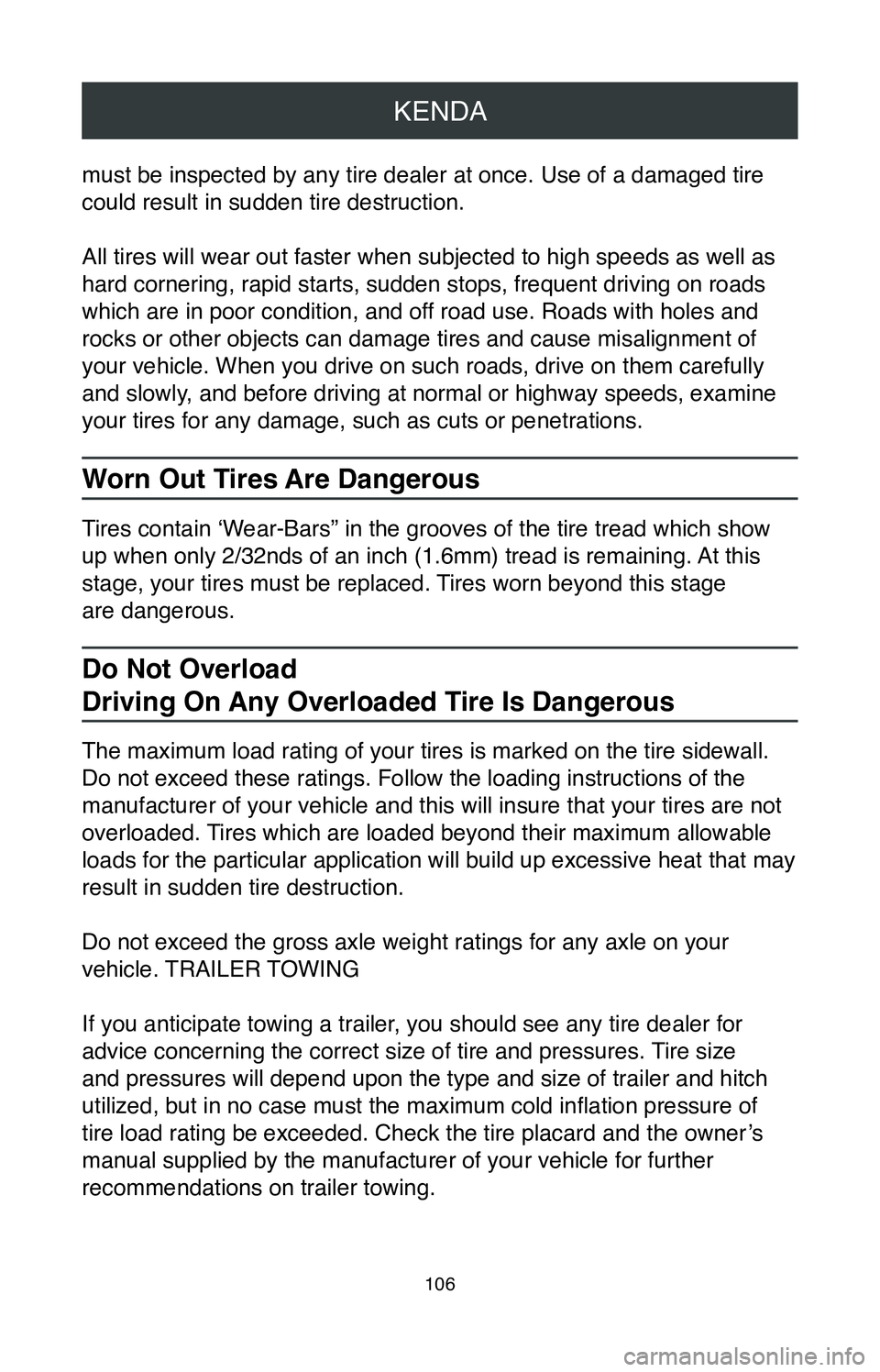
KENDA
106
must be inspected by any tire dealer at once. Use of a damaged tire
could result in sudden tire destruction.
All tires will wear out faster when subjected to high speeds as well as
hard cornering, rapid starts, sudden stops, frequent driving on roads
which are in poor condition, and off road use. Roads with holes and
rocks or other objects can damage tires and cause misalignment of
your vehicle. When you drive on such roads, drive on them carefully
and slowly, and before driving at normal or highway speeds, examine
your tires for any damage, such as cuts or penetrations.
Worn Out Tires Are Dangerous
Tires contain ‘Wear-Bars” in the grooves of the tire tread which show
up when only 2/32nds of an inch (1.6mm) tread is remaining. At this
stage, your tires must be replaced. Tires worn beyond this stage
are dangerous.
Do Not Overload
Driving On Any Overloaded Tire Is Dangerous
The maximum load rating of your tires is marked on the tire sidewall.
Do not exceed these ratings. Follow the loading instructions of the
manufacturer of your vehicle and this will insure that your tires are no\
t
overloaded. Tires which are loaded beyond their maximum allowable
loads for the particular application will build up excessive heat that m\
ay
result in sudden tire destruction.
Do not exceed the gross axle weight ratings for any axle on your
vehicle. TRAILER TOWING
If you anticipate towing a trailer, you should see any tire dealer for
advice concerning the correct size of tire and pressures. Tire size
and pressures will depend upon the type and size of trailer and hitch
utilized, but in no case must the maximum cold inflation pressure of
tire load rating be exceeded. Check the tire placard and the owner’s
manual supplied by the manufacturer of your vehicle for further
recommendations on trailer towing.
Page 109 of 260
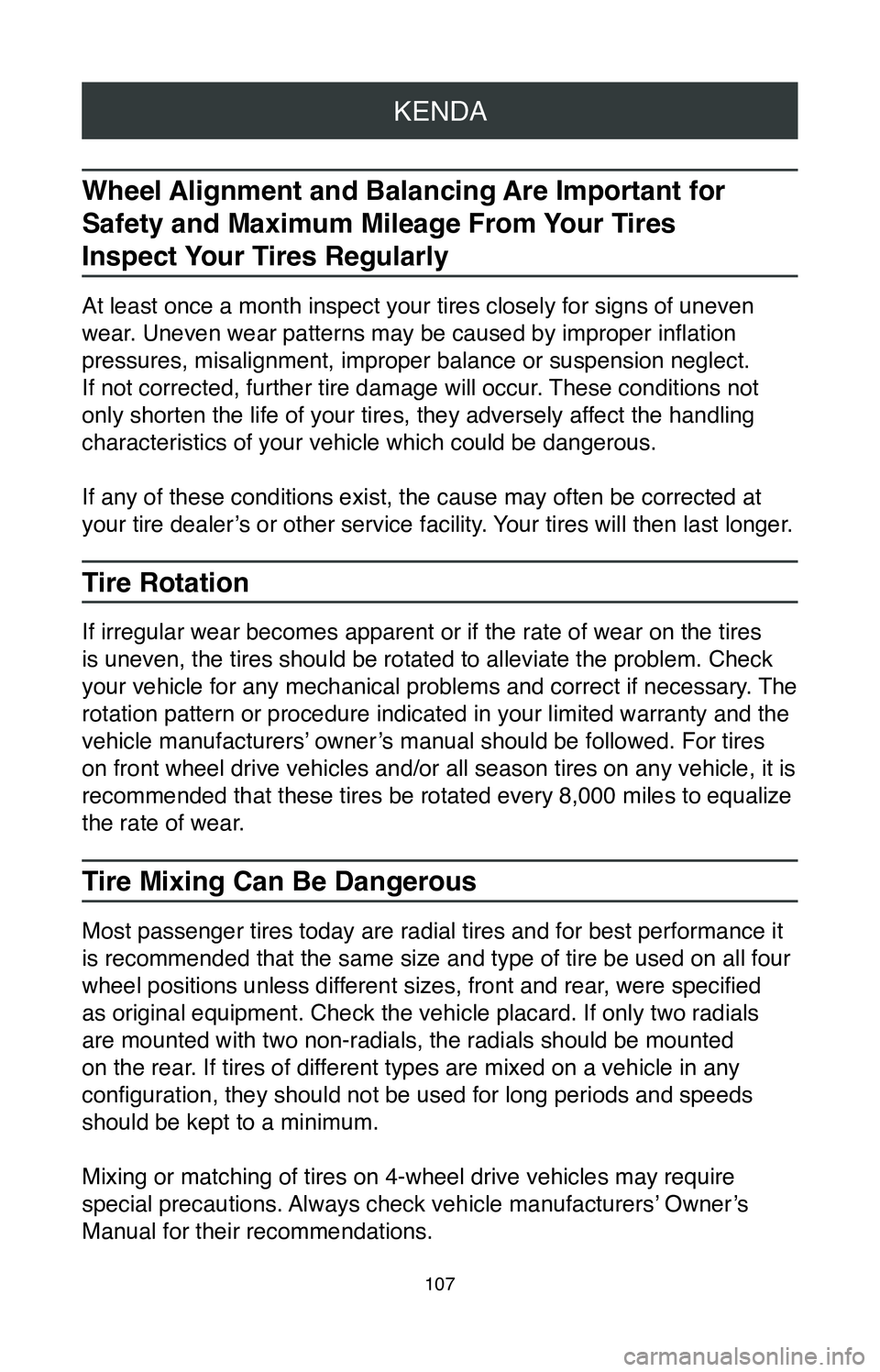
KENDA
107
Wheel Alignment and Balancing Are Important for
Safety and Maximum Mileage From Your Tires
Inspect Your Tires Regularly
At least once a month inspect your tires closely for signs of uneven
wear. Uneven wear patterns may be caused by improper inflation
pressures, misalignment, improper balance or suspension neglect.
If not corrected, further tire damage will occur. These conditions not
only shorten the life of your tires, they adversely affect the handling
characteristics of your vehicle which could be dangerous.
If any of these conditions exist, the cause may often be corrected at
your tire dealer’s or other service facility. Your tires will then last longer.
Tire Rotation
If irregular wear becomes apparent or if the rate of wear on the tires
is uneven, the tires should be rotated to alleviate the problem. Check
your vehicle for any mechanical problems and correct if necessary. The
rotation pattern or procedure indicated in your limited warranty and the\
vehicle manufacturers’ owner’s manual should be followed. For tires
on front wheel drive vehicles and/or all season tires on any vehicle, it\
is
recommended that these tires be rotated every 8,000 miles to equalize
the rate of wear.
Tire Mixing Can Be Dangerous
Most passenger tires today are radial tires and for best performance it \
is recommended that the same size and type of tire be used on all four
wheel positions unless different sizes, front and rear, were specified
as original equipment. Check the vehicle placard. If only two radials
are mounted with two non-radials, the radials should be mounted
on the rear. If tires of different types are mixed on a vehicle in any
configuration, they should not be used for long periods and speeds
should be kept to a minimum.
Mixing or matching of tires on 4-wheel drive vehicles may require
special precautions. Always check vehicle manufacturers’ Owner’s
Manual for their recommendations.
Page 111 of 260
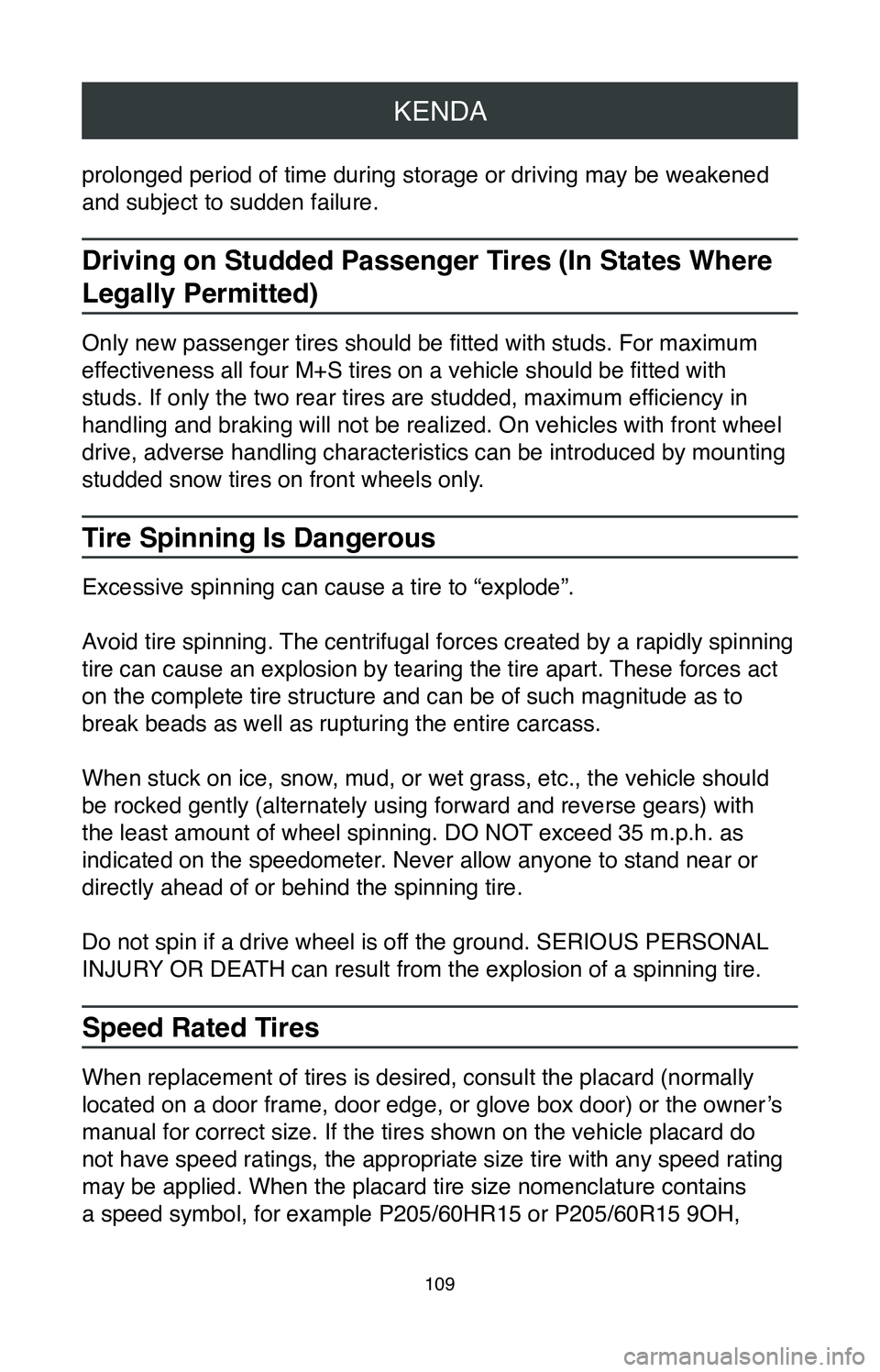
KENDA
109
prolonged period of time during storage or driving may be weakened
and subject to sudden failure.
Driving on Studded Passenger Tires (In States Where
Legally Permitted)
Only new passenger tires should be fitted with studs. For maximum
effectiveness all four M+S tires on a vehicle should be fitted with
studs. If only the two rear tires are studded, maximum efficiency in
handling and braking will not be realized. On vehicles with front wheel \
drive, adverse handling characteristics can be introduced by mounting
studded snow tires on front wheels only.
Tire Spinning Is Dangerous
Excessive spinning can cause a tire to “explode”.
Avoid tire spinning. The centrifugal forces created by a rapidly spinning
tire can cause an explosion by tearing the tire apart. These forces act
on the complete tire structure and can be of such magnitude as to
break beads as well as rupturing the entire carcass.
When stuck on ice, snow, mud, or wet grass, etc., the vehicle should
be rocked gently (alternately using forward and reverse gears) with
the least amount of wheel spinning. DO NOT exceed 35 m.p.h. as
indicated on the speedometer. Never allow anyone to stand near or
directly ahead of or behind the spinning tire.
Do not spin if a drive wheel is off the ground. SERIOUS PERSONAL
INJURY OR DEATH can result from the explosion of a spinning tire.
Speed Rated Tires
When replacement of tires is desired, consult the placard (normally
located on a door frame, door edge, or glove box door) or the owner’s
manual for correct size. If the tires shown on the vehicle placard do
not have speed ratings, the appropriate size tire with any speed rating \
may be applied. When the placard tire size nomenclature contains
a speed symbol, for example P205/60HR15 or P205/60R15 9OH,
Page 112 of 260
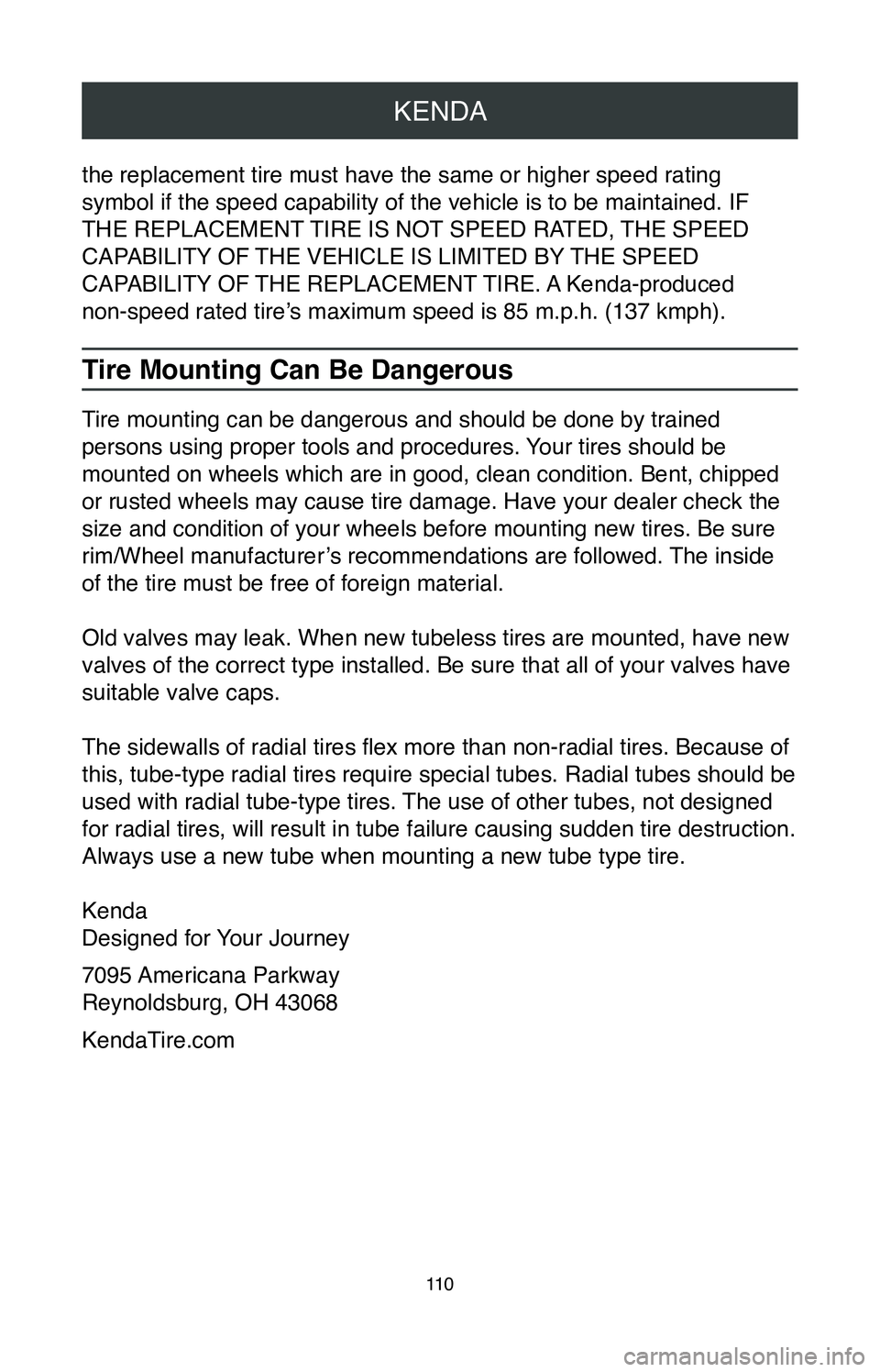
KENDA
11 0
the replacement tire must have the same or higher speed rating
symbol if the speed capability of the vehicle is to be maintained. IF
THE REPLACEMENT TIRE IS NOT SPEED RATED, THE SPEED
CAPABILITY OF THE VEHICLE IS LIMITED BY THE SPEED
CAPABILITY OF THE REPLACEMENT TIRE. A Kenda-produced
non-speed rated tire’s maximum speed is 85 m.p.h. (137 kmph).
Tire Mounting Can Be Dangerous
Tire mounting can be dangerous and should be done by trained
persons using proper tools and procedures. Your tires should be
mounted on wheels which are in good, clean condition. Bent, chipped
or rusted wheels may cause tire damage. Have your dealer check the
size and condition of your wheels before mounting new tires. Be sure
rim/Wheel manufacturer’s recommendations are followed. The inside
of the tire must be free of foreign material.
Old valves may leak. When new tubeless tires are mounted, have new
valves of the correct type installed. Be sure that all of your valves ha\
ve
suitable valve caps.
The sidewalls of radial tires flex more than non-radial tires. Because of
this, tube-type radial tires require special tubes. Radial tubes should be
used with radial tube-type tires. The use of other tubes, not designed
for radial tires, will result in tube failure causing sudden tire destru\
ction.
Always use a new tube when mounting a new tube type tire.
Kenda
Designed for Your Journey
7095 Americana Parkway
Reynoldsburg, OH 43068
KendaTire.com
Page 118 of 260
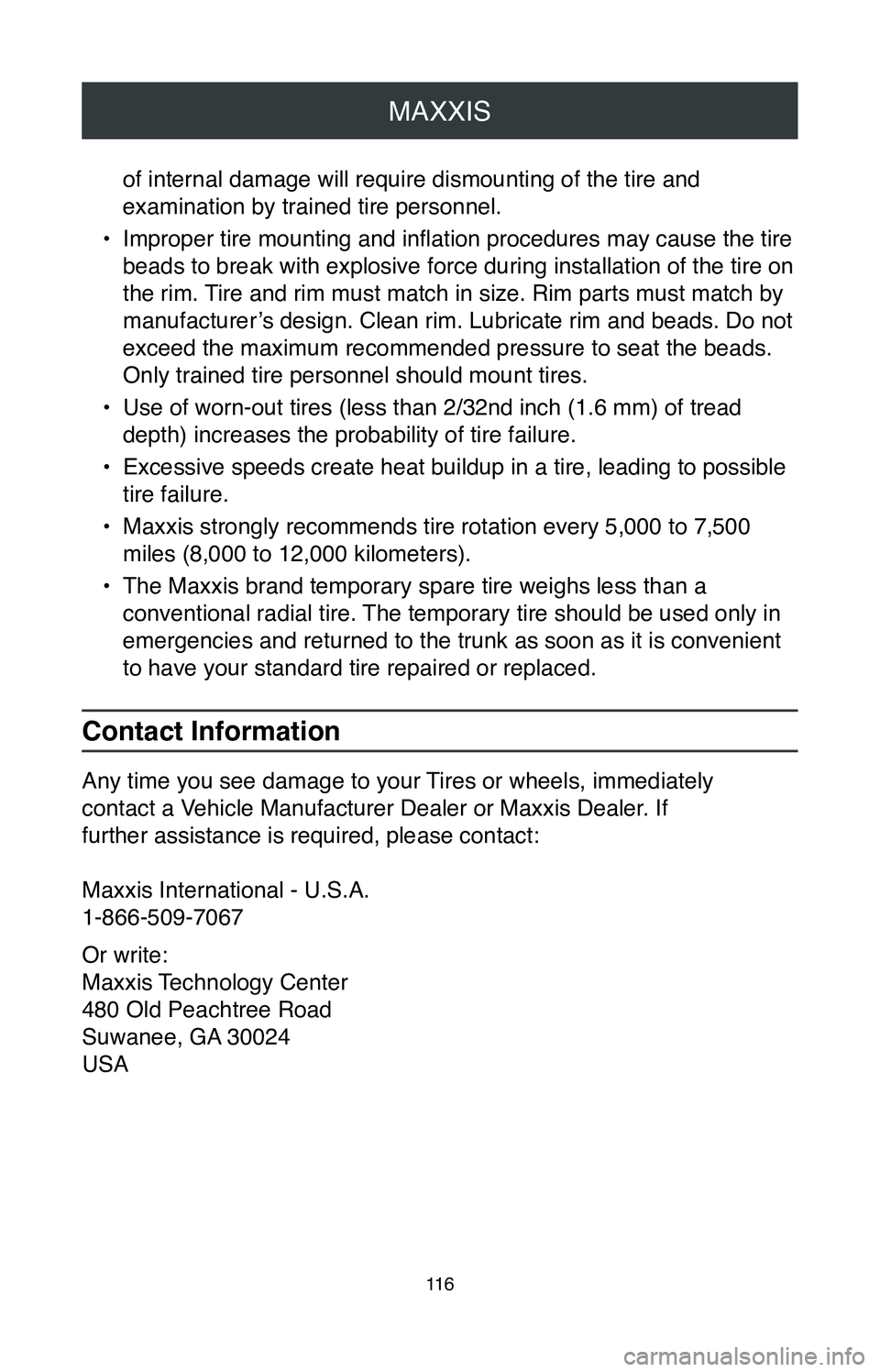
MAXXIS
11 6
of internal damage will require dismounting of the tire and
examination by trained tire personnel.
•
Improper tire mounting and inflation procedures may cause the tire
beads to break with explosive force during installation of the tire on
the rim. Tire and rim must match in size. Rim parts must match by
manufacturer’s design. Clean rim. Lubricate rim and beads. Do not
exceed the maximum recommended pressure to seat the beads.
Only trained tire personnel should mount tires.
•
Use of worn-out tires (less than 2/32nd inch (1.6 mm) of tread
depth) increases the probability of tire failure.
•
Excessive speeds create heat buildup in a tire, leading to possible
tire failure.
•
Maxxis strongly recommends tire rotation every 5,000 to 7,500
miles (8,000 to 12,000 kilometers).
•
The Maxxis brand temporary spare tire weighs less than a
conventional radial tire. The temporary tire should be used only in
emergencies and returned to the trunk as soon as it is convenient
to have your standard tire repaired or replaced.
Contact Information
Any time you see damage to your Tires or wheels, immediately
contact a Vehicle Manufacturer Dealer or Maxxis Dealer. If
further assistance is required, please contact:
Maxxis International - U.S.A.
1-866-509-7067
Or write:
Maxxis Technology Center
480 Old Peachtree Road
Suwanee, GA 30024
USA
Page 130 of 260
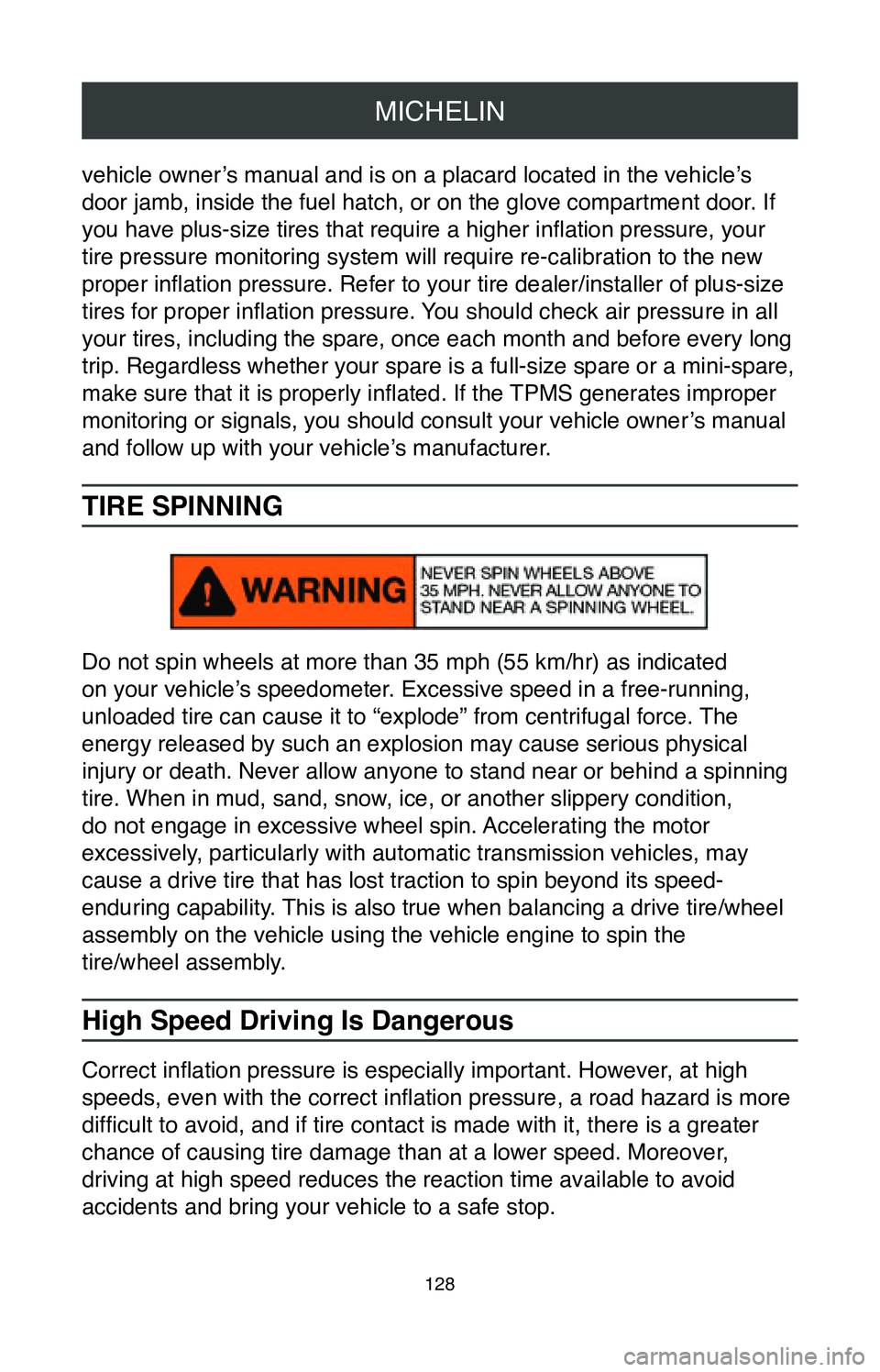
MICHELIN
128
vehicle owner’s manual and is on a placard located in the vehicle’s
door jamb, inside the fuel hatch, or on the glove compartment door. If
you have plus-size tires that require a higher inflation pressure, your
tire pressure monitoring system will require re-calibration to the new
proper inflation pressure. Refer to your tire dealer/installer of plus-size
tires for proper inflation pressure. You should check air pressure in all
your tires, including the spare, once each month and before every long
trip. Regardless whether your spare is a full-size spare or a mini-spare,
make sure that it is properly inflated. If the TPMS generates improper
monitoring or signals, you should consult your vehicle owner’s manual
and follow up with your vehicle’s manufacturer.
TIRE SPINNING
Do not spin wheels at more than 35 mph (55 km/hr) as indicated
on your vehicle’s speedometer. Excessive speed in a free-running,
unloaded tire can cause it to “explode” from centrifugal force. The
energy released by such an explosion may cause serious physical
injury or death. Never allow anyone to stand near or behind a spinning
tire. When in mud, sand, snow, ice, or another slippery condition,
do not engage in excessive wheel spin. Accelerating the motor
excessively, particularly with automatic transmission vehicles, may
cause a drive tire that has lost traction to spin beyond its speed-
enduring capability. This is also true when balancing a drive tire/wheel
assembly on the vehicle using the vehicle engine to spin the
tire/wheel assembly.
High Speed Driving Is Dangerous
Correct inflation pressure is especially important. However, at high
speeds, even with the correct inflation pressure, a road hazard is more
difficult to avoid, and if tire contact is made with it, there is a greater
chance of causing tire damage than at a lower speed. Moreover,
driving at high speed reduces the reaction time available to avoid
accidents and bring your vehicle to a safe stop.
Page 132 of 260
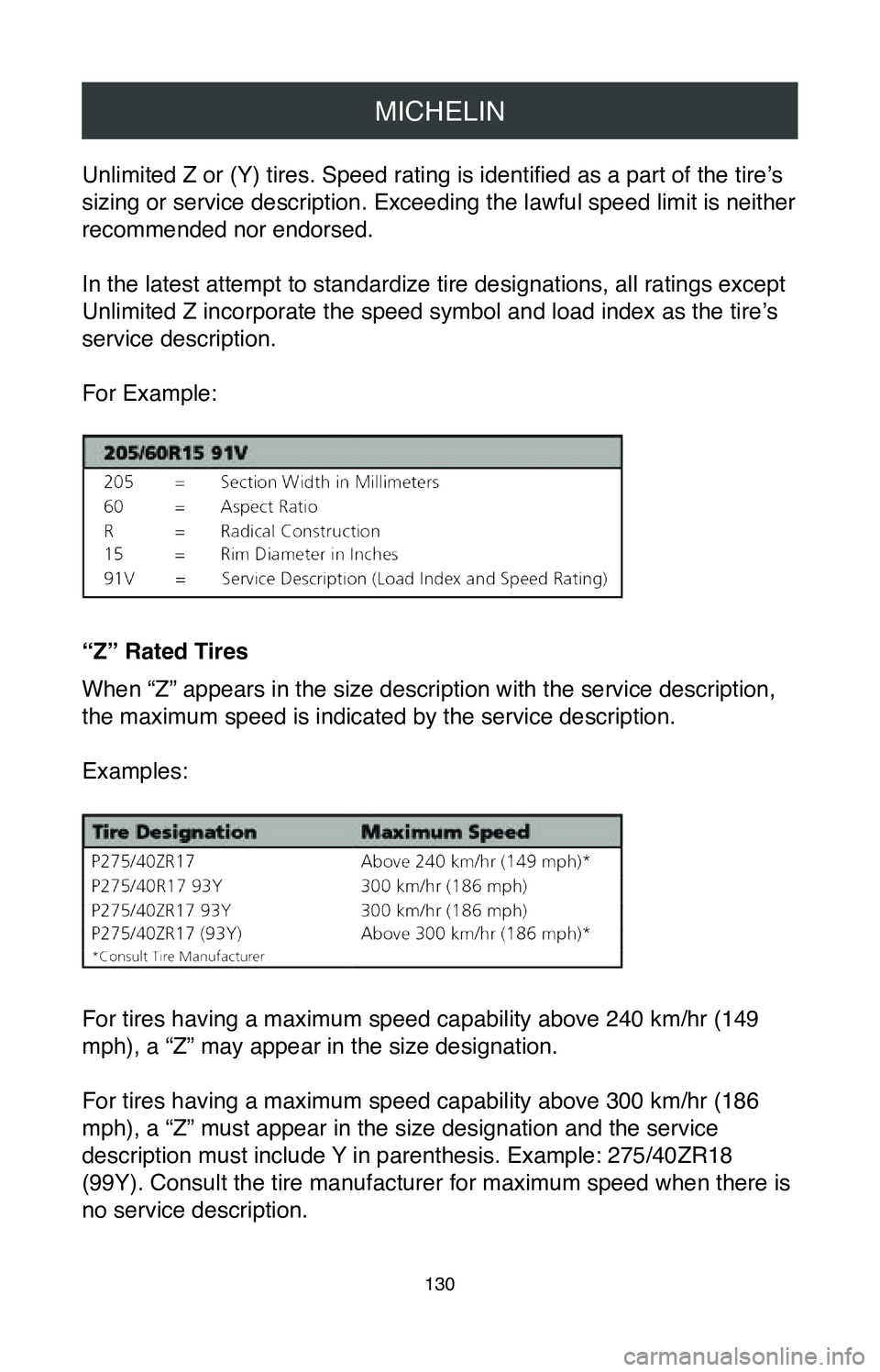
MICHELIN
130
Unlimited Z or (Y) tires. Speed rating is identified as a part of the tire’s
sizing or service description. Exceeding the lawful speed limit is neith\
er
recommended nor endorsed.
In the latest attempt to standardize tire designations, all ratings exce\
pt
Unlimited Z incorporate the speed symbol and load index as the tire’ s
service description.
For Example:
“Z” Rated Tires
When “Z” appears in the size description with the service descript\
ion,
the maximum speed is indicated by the service description.
Examples:
For tires having a maximum speed capability above 240 km/hr (149
mph), a “Z” may appear in the size designation.
For tires having a maximum speed capability above 300 km/hr (186
mph), a “Z” must appear in the size designation and the service
description must include Y in parenthesis. Example: 275/40ZR18
(99Y). Consult the tire manufacturer for maximum speed when there is
no service description.
Page 136 of 260
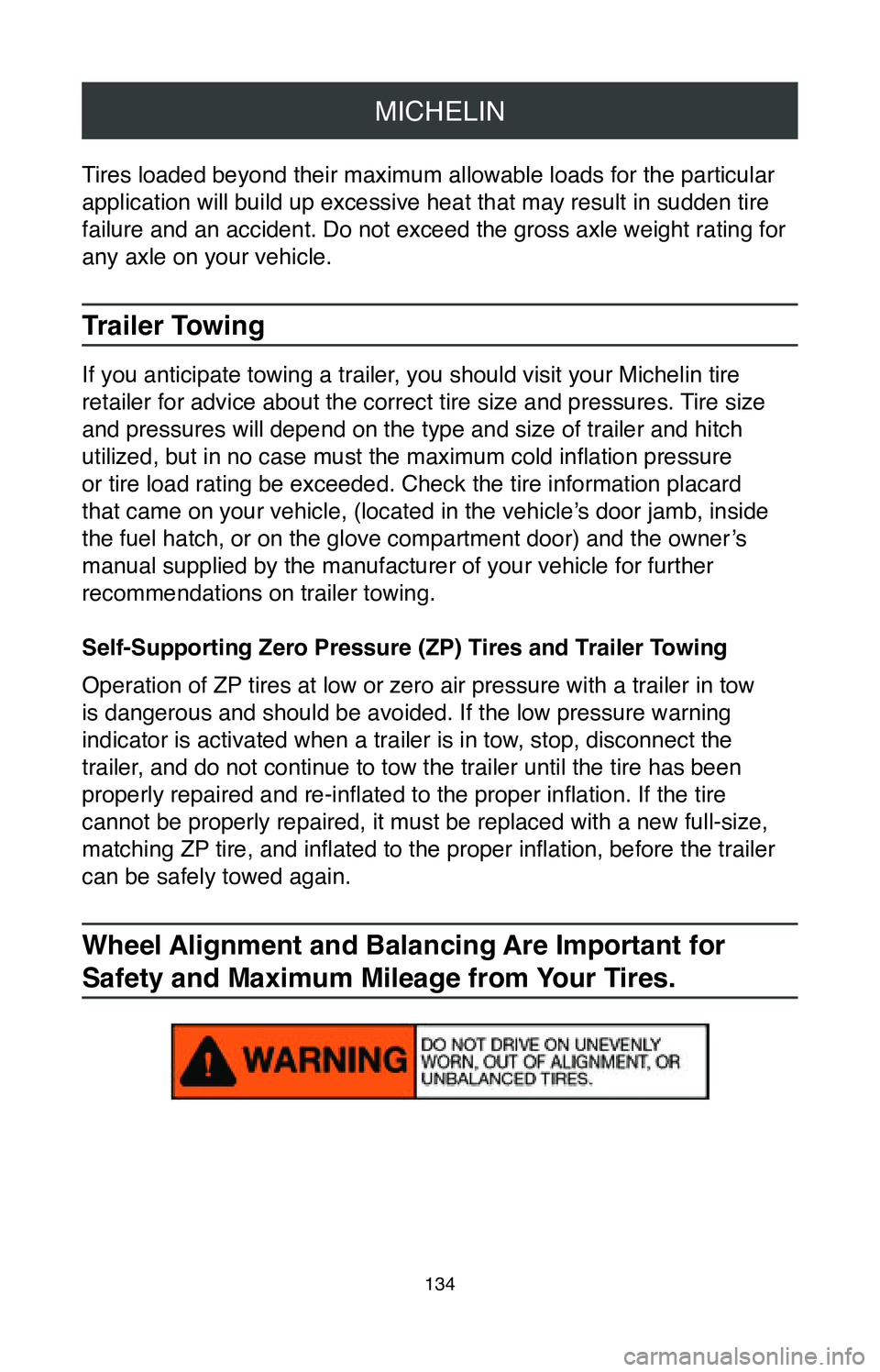
MICHELIN
134
Tires loaded beyond their maximum allowable loads for the particular
application will build up excessive heat that may result in sudden tire \
failure and an accident. Do not exceed the gross axle weight rating for \
any axle on your vehicle.
Trailer Towing
If you anticipate towing a trailer, you should visit your Michelin tire
retailer for advice about the correct tire size and pressures. Tire size
and pressures will depend on the type and size of trailer and hitch
utilized, but in no case must the maximum cold inflation pressure
or tire load rating be exceeded. Check the tire information placard
that came on your vehicle, (located in the vehicle’s door jamb, inside
the fuel hatch, or on the glove compartment door) and the owner’s
manual supplied by the manufacturer of your vehicle for further
recommendations on trailer towing.
Self-Supporting Zero Pressure (ZP) Tires and Trailer Towing
Operation of ZP tires at low or zero air pressure with a trailer in tow
is dangerous and should be avoided. If the low pressure warning
indicator is activated when a trailer is in tow, stop, disconnect the
trailer, and do not continue to tow the trailer until the tire has been
properly repaired and re-inflated to the proper inflation. If the tire
cannot be properly repaired, it must be replaced with a new full-size,
matching ZP tire, and inflated to the proper inflation, before the trailer
can be safely towed again.
Wheel Alignment and Balancing Are Important for
Safety and Maximum Mileage from Your Tires.
Page 137 of 260
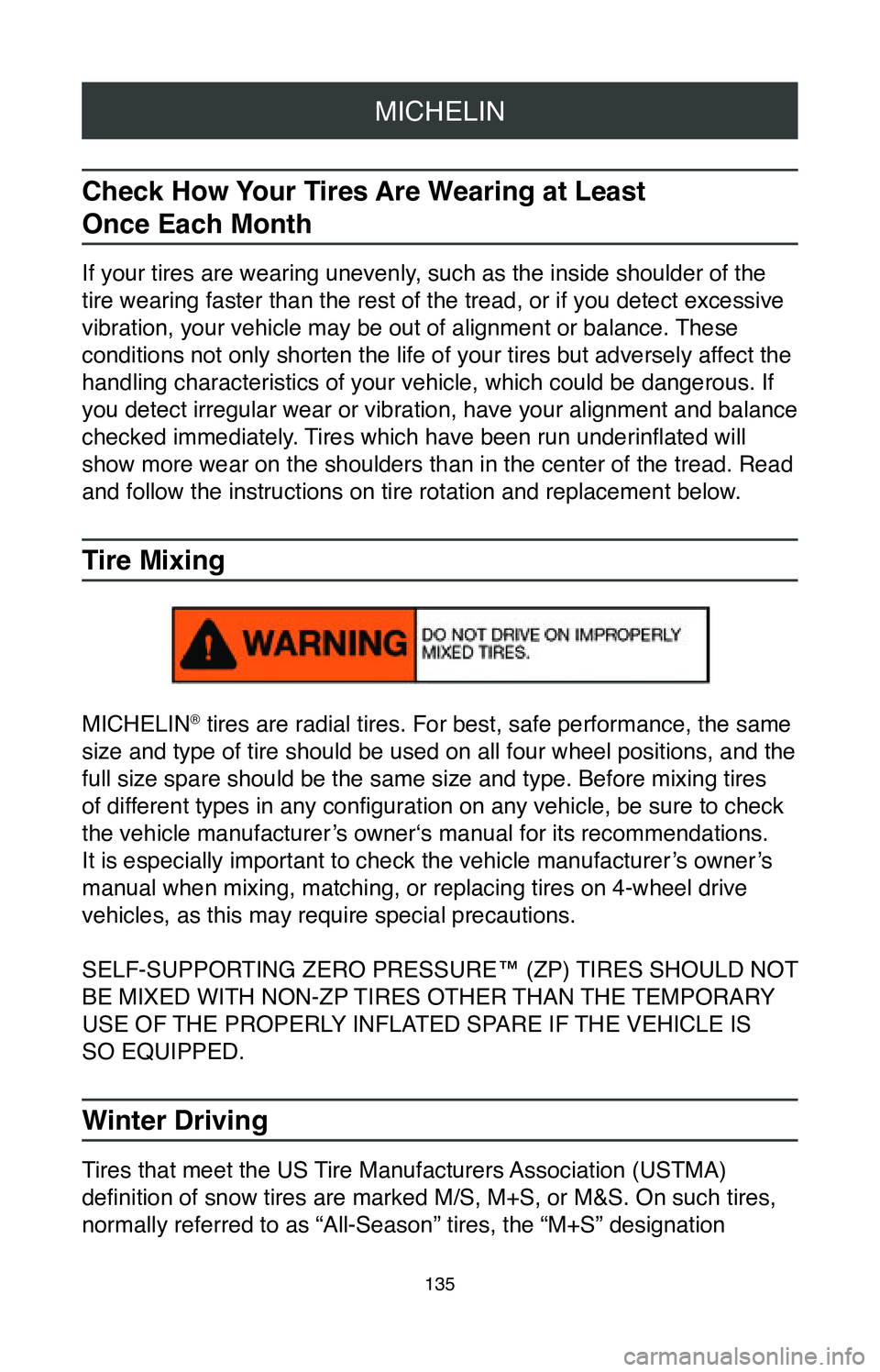
MICHELIN
135
Check How Your Tires Are Wearing at Least
Once Each Month
If your tires are wearing unevenly, such as the inside shoulder of the
tire wearing faster than the rest of the tread, or if you detect excessi\
ve
vibration, your vehicle may be out of alignment or balance. These
conditions not only shorten the life of your tires but adversely affect the
handling characteristics of your vehicle, which could be dangerous. If
you detect irregular wear or vibration, have your alignment and balance
checked immediately. Tires which have been run underinflated will
show more wear on the shoulders than in the center of the tread. Read
and follow the instructions on tire rotation and replacement below.
Tire Mixing
MICHELIN® tires are radial tires. For best, safe performance, the same
size and type of tire should be used on all four wheel positions, and th\
e
full size spare should be the same size and type. Before mixing tires
of different types in any configuration on any vehicle, be sure to check
the vehicle manufacturer’s owner‘s manual for its recommendations.
It is especially important to check the vehicle manufacturer’s owner’s
manual when mixing, matching, or replacing tires on 4-wheel drive
vehicles, as this may require special precautions.
SELF-SUPPORTING ZERO PRESSURE™ (ZP) TIRES SHOULD NOT
BE MIXED WITH NON-ZP TIRES OTHER THAN THE TEMPORARY
USE OF THE PROPERLY INFLATED SPARE IF THE VEHICLE IS
SO EQUIPPED.
Winter Driving
Tires that meet the US Tire Manufacturers Association (USTMA)
definition of snow tires are marked M/S, M+S, or M&S. On such tires,
normally referred to as “All-Season” tires, the “M+S” designation
Page 139 of 260
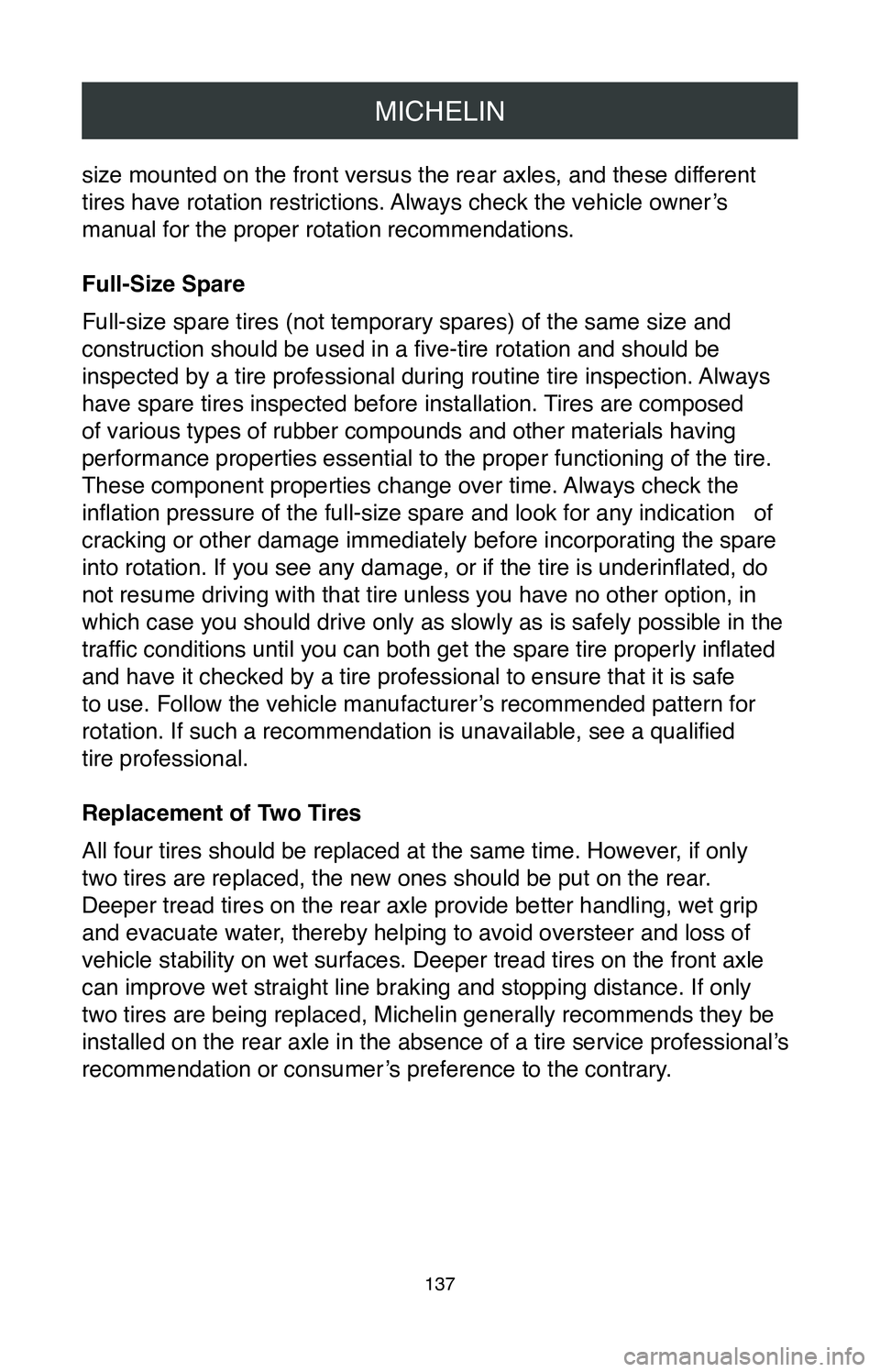
MICHELIN
137
size mounted on the front versus the rear axles, and these different
tires have rotation restrictions. Always check the vehicle owner’s
manual for the proper rotation recommendations.
Full-Size Spare
Full-size spare tires (not temporary spares) of the same size and
construction should be used in a five-tire rotation and should be
inspected by a tire professional during routine tire inspection. Always
have spare tires inspected before installation. Tires are composed
of various types of rubber compounds and other materials having
performance properties essential to the proper functioning of the tire. \
These component properties change over time. Always check the
inflation pressure of the full-size spare and look for any indication of
cracking or other damage immediately before incorporating the spare
into rotation. If you see any damage, or if the tire is underinflated, do
not resume driving with that tire unless you have no other option, in
which case you should drive only as slowly as is safely possible in the \
traffic conditions until you can both get the spare tire properly inflated
and have it checked by a tire professional to ensure that it is safe
to use. Follow the vehicle manufacturer’s recommended pattern for
rotation. If such a recommendation is unavailable, see a qualified
tire professional.
Replacement of Two Tires
All four tires should be replaced at the same time. However, if only
two tires are replaced, the new ones should be put on the rear.
Deeper tread tires on the rear axle provide better handling, wet grip
and evacuate water, thereby helping to avoid oversteer and loss of
vehicle stability on wet surfaces. Deeper tread tires on the front axle \
can improve wet straight line braking and stopping distance. If only
two tires are being replaced, Michelin generally recommends they be
installed on the rear axle in the absence of a tire service professional’ s
recommendation or consumer’s preference to the contrary.